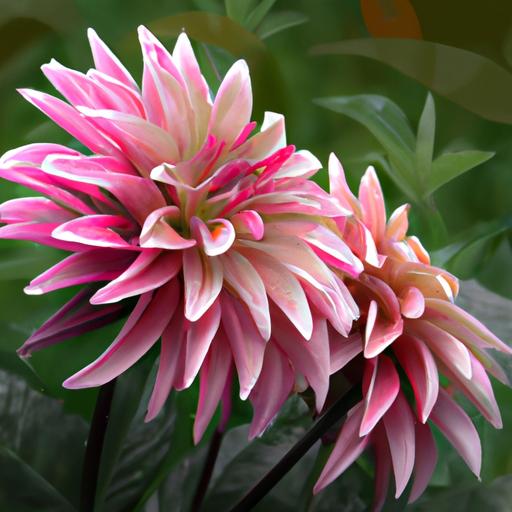Have you noticed the leaves on your dahlia plant turning brown? You’re not alone; brown leaves on dahlias are a common problem. Take heart, though: there are ways to fix the issue. In this article, we’ll look at the causes of brown leaves on dahlias, the symptoms of browning leaves, and how to correct the problem. So, if you’re ready to learn why your dahlia leaves are turning brown and what you can do about it, keep reading!
Table of Contents
Short Answer
It is likely that your dahlia is suffering from a lack of water.
Dahlias should be watered regularly to keep their leaves green and healthy.
If the soil is too dry or if there is not enough water, the leaves can start to turn brown.
Additionally, your dahlia may be suffering from too much sun, which can also cause the leaves to turn brown.
Make sure to monitor the soil moisture and sunlight levels to ensure your dahlia is getting the right amount of both.
What Causes Dahlia Leaves to Turn Brown?
When it comes to dahlias, brown leaves can be a sign of distress.
There are many potential causes of brown leaves, including too much direct sunlight, over-watering, and inadequate nutrients in the soil.
All of these factors can cause the leaves to turn brown, wilt, and eventually die.
Too much direct sunlight can cause dahlia leaves to become scorched and browned.
Dahlias need at least 6 hours of direct sunlight a day, but if they are exposed to more than this, the leaves can become damaged.
The higher the temperature, the more likely the leaves are to become stressed and brown.
Over-watering is also a common cause of brown dahlia leaves.
If the plant is watered too often, it can cause the soil to become waterlogged and the leaves to turn brown due to lack of oxygen.
It is important to water your dahlias regularly, but not to the point of saturation.
Inadequate nutrients in the soil can also lead to browning leaves.
Dahlias need nutrient-rich soil to thrive, and if the soil is lacking in essential nutrients, the leaves can become brown and weak.
It is important to use a soil that is specifically formulated for dahlias and to regularly fertilize the plant.
If your dahlia leaves are turning brown, it is important to diagnose the cause quickly in order to save your plants.
Check the soil moisture and nutrient levels, adjust the amount of sunlight, and make sure the plant is getting proper drainage.
With the right care, your dahlias will be back in full bloom in no time.
Symptoms of Browning Leaves

Browning dahlia leaves can be worrying for gardeners, but its important to remember that its often a sign of something going wrong, rather than a cause for alarm.
There are a few common signs to look out for that can help identify the cause of the problem.
First, the leaves of a dahlia will start to turn brown, starting from the outer edges and working inwards.
This can happen gradually or very quickly, depending on the cause.
The leaves may also start to curl and become brittle, and can eventually fall off the plant.
In some cases, the leaves may become discolored, with yellow, white, or black spots appearing.
The stems may also start to wilt, and the flowers may drop prematurely.
Its important to act quickly if you notice these symptoms, as browning leaves can be a sign of a serious problem.
Its best to diagnose the cause of the problem and take steps to rectify it as soon as possible in order to keep your dahlias in perfect health.
Overwatering
When it comes to dahlias, one of the most common causes of brown leaves is overwatering.
Too much water can lead to root rot, which can cause the leaves to turn brown and wilt.
To prevent this, make sure that the soil is dry to the touch before you water the plant and dont water too frequently.
If the soil is still wet after a few days, then you may be overwatering.
If the leaves are still brown after a few days, then you may need to adjust your watering schedule.
Additionally, make sure that your dahlia is receiving proper drainage, as excess water can cause the roots to rot more quickly.
Not Enough Sunlight

When it comes to why dahlia leaves are turning brown, not enough sunlight is one possible cause.
While dahlias need plenty of sunlight to thrive, too much can also be damaging.
If your dahlia is exposed to too much direct sunlight, the leaves may start to turn brown and wilt.
This is often the result of too much heat, which can dry out the leaves and cause them to become brittle and discolored.
To solve this problem, make sure that your dahlia is in a sunny spot but not one that gets too much direct sunlight.
If you can, try to provide some shade for your dahlia during the hottest times of the day.
If you’re growing your dahlia indoors, make sure that it’s getting plenty of indirect sunlight.
Additionally, make sure that your dahlia is well-watered and that the soil isn’t drying out too quickly.
Poor Soil Nutrients
Poor soil nutrients can be one of the main causes of dahlia leaves turning brown.
When the soil lacks the necessary nutrients, the dahlia plants can become weak and the leaves may start to wilt and turn brown.
To diagnose this issue, you should examine the soil to see if it is too acidic or too alkaline.
A soil test can also be done to check the nutrient levels and pH balance.
To fix this problem, you should add organic matter such as compost to the soil, which will help enrich the soil and replenish the nutrients.
You can also use a balanced fertilizer to help restore the soils nutrient levels.
Additionally, adding mulch to the soil can help keep it moist and prevent the nutrients from washing away.
Once the soil is properly nourished, your dahlia plants should start to revive and the leaves should regain their vibrant green color.
With the right care and attention, you can ensure that your dahlia plants stay healthy and continue to bloom for many seasons to come.
Poor Drainage

Poor drainage can be a major cause of dahlia leaves turning brown.
When soil doesn’t drain properly, it can cause the roots to become waterlogged and unable to absorb the necessary nutrients and oxygen from the soil.
This can lead to the plant’s leaves turning yellow or brown and wilting.
To check for poor drainage, dig around the base of the dahlia and take a look at the soil.
If it is consistently soggy or has standing water, then you will need to improve the drainage of the soil.
This can be done by adding organic matter such as compost, sand, or gravel to the soil to increase the porosity and allow for better drainage.
Additionally, consider planting your dahlia in a raised bed or container to ensure that the plant is not sitting in water.
Correcting the Problem
If your dahlia leaves are turning brown, it’s important to take action quickly in order to save your plants.
Before taking any steps, however, you should first diagnose the cause of the problem.
Possible causes of browning leaves include too much direct sunlight, over-watering, or inadequate nutrients in the soil.
Once you have identified the cause, you can then take the appropriate measures to correct it.
If the problem is too much direct sunlight, try to adjust the amount of sunlight the plant is getting.
This can be done by moving the dahlia to a shadier spot in your garden, or by providing it with some sort of shade, such as a lattice or a sun umbrella.
If the problem is over-watering, the best solution is to reduce the amount of water you are giving your dahlias.
Make sure to water your dahlias only when the top 1-2 inches of soil is dry.
You should also check the soil moisture levels regularly, as this can help you determine when to water and when to stop.
Finally, if the problem is inadequate nutrients in the soil, you can add fertilizer to your dahlias according to the instructions on the package.
Additionally, make sure that your dahlias are getting proper drainage, as this can help prevent the leaves from turning brown.
With the right care, your dahlias will soon be back in full bloom, bringing life and color to your garden once again.
Final Thoughts
When dahlia leaves start to turn brown, it can be a disheartening sight.
But with a little detective work and the right care, you can diagnose and fix the problem.
Check the soil moisture and nutrient levels, adjust the amount of sunlight, and make sure the plant is getting proper drainage.
With the right care, your dahlias will be back in full bloom in no time.
So take action and keep your garden looking beautiful!

